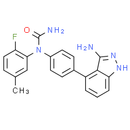Description
Linifanib, also known as ABT-869, is an orally bioavailable, small-molecule receptor tyrosine kinase (RTK) inhibitor with potential antineoplastic activity. Linifanib inhibits members of the vascular endothelial growth factor (VEGF) and platelet-derived growth factor (PDGF) receptor families; it exhibits much less activity against unrelated RTKs, soluble tyrosine kinases, or serine/threonine kinases. This agent does not have a general antiproliferative effect due to its high dose requirement. However, linifanib may exhibit potent antiproliferative and apoptotic effects on tumor cells whose proliferation is dependent on mutant kinases, such as fms-related tyrosine kinase receptor-3 (FLT3).
Product information
CAS Number: 796967-16-3
Molecular Weight: 375.40
Formula: C21H18FN5O
Synonym:
ABT869
ABT 869
Chemical Name: N-[4-(3-amino-1H-indazol-4-yl)phenyl]-N1-(2-fluoro-5-methylphenyl) urea
Smiles: CC1=CC(=C(F)C=C1)N(C1C=CC(=CC=1)C1C=CC=C2NN=C(N)C=12)C(N)=O
InChiKey: ACPCMBPQKQTAQY-UHFFFAOYSA-N
InChi: InChI=1S/C21H18FN5O/c1-12-5-10-16(22)18(11-12)27(21(24)28)14-8-6-13(7-9-14)15-3-2-4-17-19(15)20(23)26-25-17/h2-11H,1H3,(H2,24,28)(H3,23,25,26)
Technical Data
Appearance: Solid Power
Purity: ≥98% (or refer to the Certificate of Analysis)
Solubility: DMSO: 75 mg/mL(199.78 mM). Water: Insoluble.
Shipping Condition: Shipped under ambient temperature as non-hazardous chemical or refer to Certificate of Analysis
Storage Condition: Dry, dark and -20 oC for 1 year or refer to the Certificate of Analysis.
Shelf Life: ≥12 months if stored properly.
Stock Solution Storage: 0 - 4 oC for 1 month or refer to the Certificate of Analysis.
Drug Formulation: To be determined
HS Tariff Code: 382200
How to use
In Vitro:
Linifanib shows inhibitory to Kit, PDGFRβ and Flt4 with IC50 of 14 nM, 66 nM and 190 nM in kinases assay. Linifanib also inhibits ligand-induced KDR, PDGFRβ, Kit, and CSF-1R phosphorylation with IC50 of 2 nM, 2 nM, 31 nM and 10 nM at cellular level and this cellular potency could be affected by serum protein. Linifanib suppresses VEGF-stimulated HUAEC proliferation with IC50 of 0.2 nM. While Linifanib has weak activity against tumor cells which are not induced by VEGF or PDGF, except for MV4-11 leukemia cells (with constitutively active form of Flt3) with IC50 of 4 nM. Linifanib could cause a decrease in S and G2-M phases with a corresponding increase in the sub-G0-G1 apoptotic population in MV4-11 cells. Linifanib binds to the ATP-binding site of CSF-1R with Ki of 3 nM. Linifanib (10 nM) exhibits a reduced phosphorylation of Akt at Ser473 and decreased phosphorylation of GSK3βat Ser9 in Ba/F3 FLT3 ITD cell lines.
In Vivo:
Linifanib (0.3 mg/kg) results in complete inhibition of KDR phosphorylation in lung tissue. Linifanib also inhibits the edema response with ED50 of 0.5 mg/kg. Linifanib (7.5 and 15 mg/kg, bid) significantly inhibits both bFGF- and VEGF-induced angiogenesis in the cornea. Linifanib inhibits tumor growth in flank xenograft models including HT1080, H526, MX-1 and DLD-1 with ED75 from 4.5-12 mg/kg. Linifanib also shows efficacy in A431 and MV4-11 xenografts at low dose levels. Linifanib (12.5 mg/kg bid) reveals a decrease of microvasculure density in MDA-231 xenograft. Linifanib shows a Cmax and AUC24 hours with 0.4 μg/mL and 2.7 μg•hour/mL in HT1080 fibrosarcoma model.
References:
- Albert DH, et al. Mol Cancer Ther, 2006, 5(4), 995-1006.
- Guo J, et al. Mol Cancer Ther, 2006, 5(4), 1007-1013.
- Hernandez-Davies JE, et al. Mol Cancer Ther, 2011, 10(6), 949-959.
- Jasinghe VJ, et al. J Hepatol. 2008, 49(6), 985-997.
- Albert DH, et al. Mol Cancer Ther. 2006, 5(4), 995-1006.
Products are for research use only. Not for human use.
Payment & Security
Your payment information is processed securely. We do not store credit card details nor have access to your credit card information.


